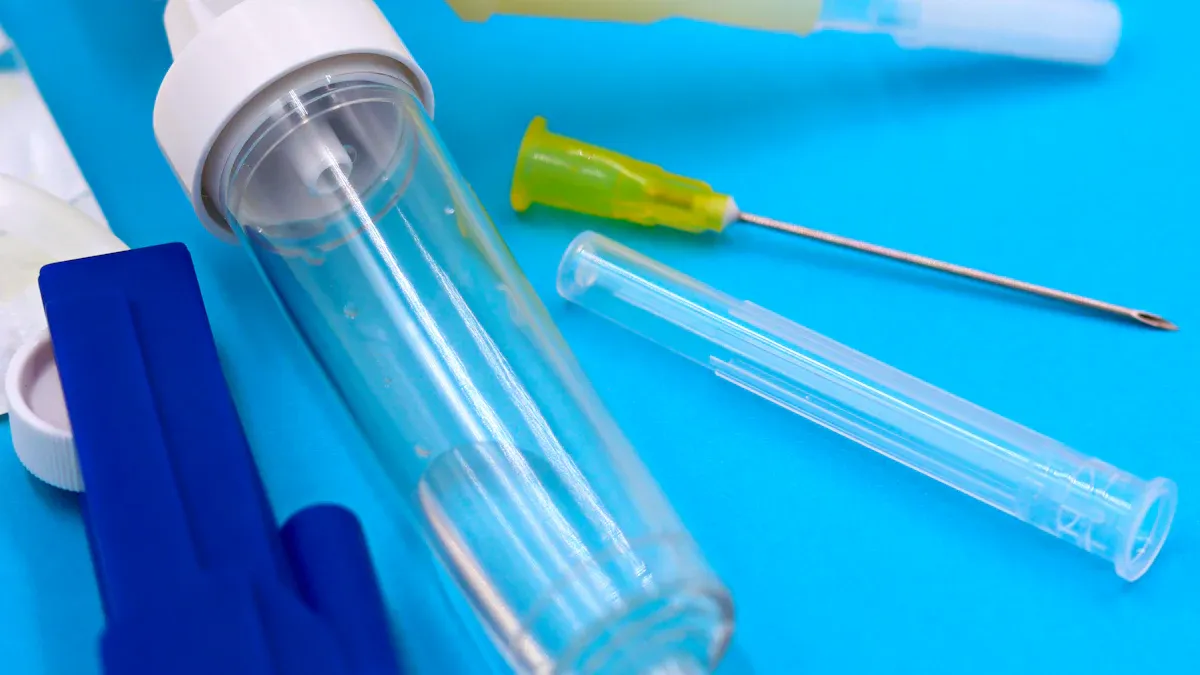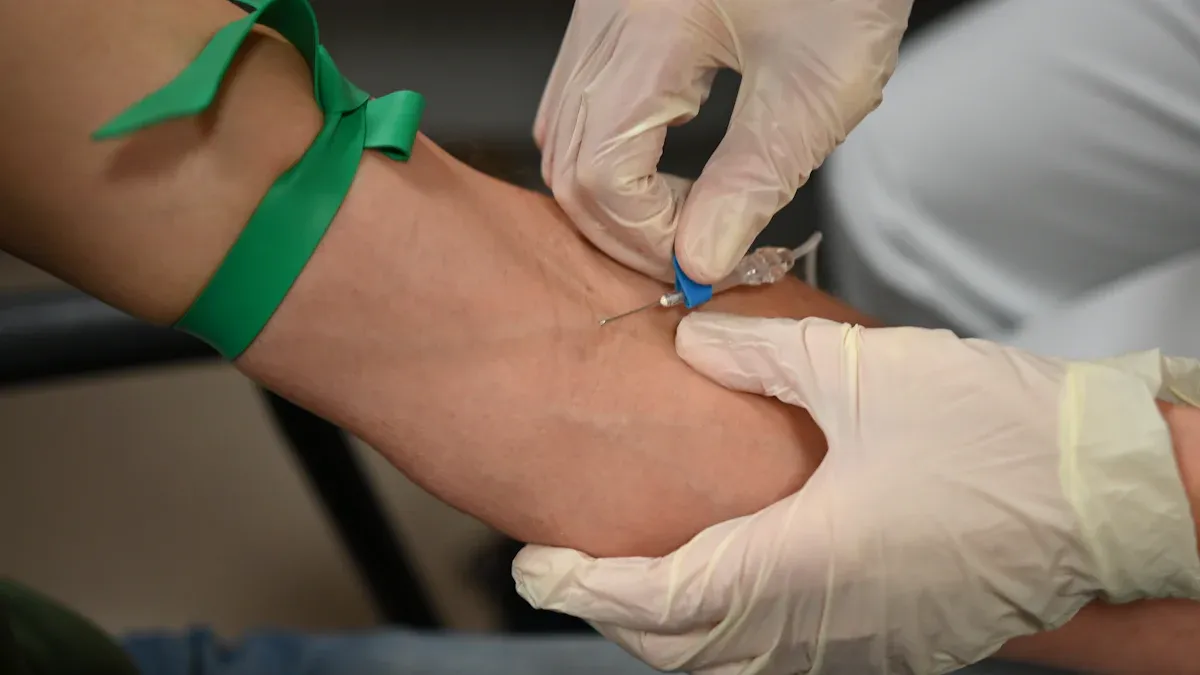Nitinol Tubing for Vascular Access: Which is Best?

Choosing the right Nitinol tubing for vascular access devices helps these medical tools work effectively and remain safe. It is crucial to match the tubing to specific medical needs. The correct Nitinol tubing can significantly improve patient outcomes. Nitinol is unique because it can bend and return to its original shape without breaking, which enhances the accuracy of surgeries and reduces risks. Additionally, it integrates well with the body, leading to fewer adverse reactions, making it suitable for long-term use. Research indicates that Nitinol tubing has a strong tensile strength of about 500 MPa. These characteristics make it a dependable choice for advanced vascular access devices.
Key Takeaways
Nitinol tubing bends easily and remembers its shape, making it great for surgeries and safer for nearby tissues.
It is strong and does not rust, which helps medical tools last longer.
Picking the right type of Nitinol—Standard, Precision, or Premium—depends on the medical use and needs.
Buying good-quality Nitinol tubing can save money over time by needing fewer fixes or replacements.
Always test samples and make sure they follow safety rules to confirm the Nitinol tubing works well and is safe.
Key Factors in Choosing Nitinol Tubing for Vascular Access Devices

Flexibility and Shape Memory
Flexibility and shape memory are very important for nitinol tubing. These features help the tubing move with the body naturally. Nitinol can bend and still return to its original shape. This special ability makes it work well during surgeries like placing stents or using guidewires. Its tensile strength, between 500–900 MPa, makes it strong for tough medical tasks. The tubing's flexibility also protects nearby tissues from harm. This makes it great for procedures that are less invasive.
Durability and Corrosion Resistance
Durability is key when picking nitinol tubing for medical tools. Nitinol lasts long because of its shape memory and flexibility. It also resists rust, even when exposed to body fluids often. A smooth surface finish improves its resistance to corrosion. Studies show smoother nitinol stents are less likely to develop weak spots. By resisting rust, nitinol tubing stays strong and safe for a long time. This makes it reliable for vascular medical uses.
Biocompatibility and Safety
Nitinol tubing works well with the body, causing fewer bad reactions. This makes it a safe option for long-term medical devices. Its rust resistance also helps keep harmful particles out of the body. Choosing nitinol tubing ensures the device stays safe and works well over time. Its mix of safety and performance makes it a top choice for vascular tools.
Cost-Effectiveness and Long-Term Value
When picking nitinol tubing for vascular devices, think about cost and value. Nitinol is strong, flexible, and works well with the body. These features mean it doesn’t need to be replaced often. This makes it a smart choice for medical tools.
A big benefit of nitinol is how it lasts over time. Its shape memory and flexibility keep it working after many uses. This reduces the chance of device failure, saving money on fixes or replacements. Also, its rust resistance helps it stay strong in body fluids, making it last longer.
Tip: Spending more on good nitinol tubing now can save money later by cutting repair and replacement costs.
The special metals in nitinol make it cost-effective. These metals handle tough conditions, perfect for medical use. While nitinol may cost more at first, its long-term benefits are worth it. For example, it works well with the body, lowering risks of problems and cutting healthcare costs.
To get the best value, think about what you need. If your device faces high pressure, premium nitinol might be better. For simpler tasks, regular nitinol could work fine.
Choosing nitinol tubing gives you reliable tools and saves money over time. Its special features make it a great pick for vascular devices.
Comparing Nitinol Tubing for Vascular Interventional Medical Devices
Standard Grade: Features, Strengths, and Ideal Uses
Standard-grade nitinol tubing is affordable and works well. It is great for devices needing medium flexibility and strength. This type has shape memory and superelasticity, making it useful for stents. These stents are often used in less challenging conditions. Its tensile strength is between 500 and 900 MPa. This strength helps it handle regular medical tasks easily.
Tests show it lasts long and stays reliable under stress. For instance, it performs well when bent or stretched repeatedly. It also resists rust, even when exposed to body fluids. These qualities make it a safe and solid choice for basic vascular tools.
Precision Grade: Features, Strengths, and Ideal Uses
Precision-grade nitinol tubing is perfect for tasks needing high accuracy. It can bend and return to its shape, which helps in surgeries. This grade is safe for the body and resists rust. It works well for implants like advanced stents used long-term.
Compared to steel or titanium, it is more flexible and durable. It is great for areas where the tubing must move a lot. Its strength and flexibility make it ideal for improving vascular medical tools.
Premium Grade: Features, Strengths, and Ideal Uses
Premium-grade nitinol tubing is the best quality available. It is made for tough medical jobs, like stents in high-pressure areas. This type lasts long and handles stress without breaking.
It is made using advanced methods to improve its strength. Its rust resistance and tensile strength are better than other grades. This makes it the top choice for important vascular tools where safety matters most.
Application-Specific Recommendations for Nitinol Tubing

Best for Long-Term Vascular Access
For long-term use, tubing must be strong and reliable. Nitinol tubing is great because it lasts a long time. Its strength helps it handle repeated use without breaking. Research shows how it’s made affects its durability. For instance, TM-2 diamond-made tubes resist breaking better than TM-1 ones. This makes TM-2 nitinol tubing a top pick for long-term needs.
Nitinol also works well with the body, causing fewer bad reactions. Its rust resistance helps it last longer, even in body fluids. This makes it perfect for stents used in long treatments. When picking nitinol tubing for long-term use, choose ones with proven strength and durability.
Best for High-Pressure Environments
Nitinol tubing is great for high-pressure conditions. It can bend and return to its shape easily. This makes it dependable in tough situations where stress is constant. Studies show nitinol performs well under high pressure, making it ideal for stents in arteries with fast blood flow.
Its rust resistance keeps it strong in body fluids over time. Nitinol also works safely with the body, lowering risks of problems. For high-pressure uses, nitinol tubing is strong and reliable, perfect for important medical tools.
Best for Minimally Invasive Vascular Procedures
Minimally invasive procedures need tubing that is flexible and safe. Nitinol tubing is perfect for this. It bends easily to move through tricky pathways without harming tissues. This makes it great for guidewires and stents in delicate surgeries.
Nitinol’s shape memory helps it keep its form after bending. This improves accuracy and lowers risks during procedures. Its smooth surface also reduces friction, making it easier to insert. For minimally invasive procedures, nitinol tubing offers the safety and precision needed for success.
Expert Tips for Choosing the Right Nitinol Tubing
Work with Manufacturers for Custom Options
Talking to manufacturers can help you pick the best nitinol tubing. They often create custom solutions for special medical needs. For example, if you need tubing for a stent in a high-pressure artery, they can adjust its strength and flexibility. Sharing your needs ensures the tubing works well in its environment.
Manufacturers also know about new nitinol technology. This helps you stay updated when making advanced vascular tools. Always explain your goals clearly to get the right product.
Test Samples to Check Performance
Testing samples is important to see if the tubing works well. Before buying a lot, ask for samples and test them in real-like conditions. For example, if you’re making a stent for small surgeries, check its flexibility and shape memory in practice setups.
Advanced tests, like electron and optical microscopy, show the tubing’s quality. These tests check for weaknesses, fatigue, and tiny flaws at 100 nm/pixel resolution. Looking at 40 areas per surface helps find problems and ensures the tubing is reliable for important uses.
Tip: Testing samples avoids mistakes and ensures high-quality products.
Check Regulatory Approvals and Certifications
Following rules is very important when picking nitinol tubing for medical tools. In the U.S., nitinol devices like stents need strict safety and fatigue tests. The FDA makes sure the tubing is safe for long-term use. But delays can happen if standards aren’t met. A 2022 study showed 75% of companies faced 12–18 month delays due to these rules.
In Europe, the MDR requires extra tests, like checking for rust and nickel release. Some companies stopped nitinol projects because of high costs and tough rules. To avoid problems, make sure the tubing meets all needed approvals and certifications.
Note: Following rules keeps devices safe and speeds up approval times.
When picking Nitinol tubing for vascular devices, focus on important features. These include flexibility, strength, safety with the body, and cost. Different grades—Standard, Precision, and Premium—fit various medical needs.
Feature | What It Does |
|---|---|
Superelasticity | Helps tubing return to shape after bending, great for movement. |
Biocompatibility | Works safely inside the body for long periods. |
Corrosion Resistance | Prevents rust, making it last longer in medical tools. |
Fatigue Performance | As strong as stainless steel, stays flexible and reliable. |
Standard-grade tubing is good for simple tools with average needs.
Precision-grade tubing works best for accurate tasks like advanced stents.
Premium-grade tubing handles high pressure and critical medical jobs.
Tip: The way tubing is made affects its strength and how long it lasts. Always check the process for better performance.
FAQ
Why is Nitinol tubing special for vascular devices?
Nitinol tubing is unique because it bends and springs back. It is safe for the body, even for long-term use. This makes it great for tools like stents and guidewires.
How can I pick the right Nitinol tubing grade?
Think about what your device needs. Standard-grade is good for simple tasks. Precision-grade is better for accurate jobs. Premium-grade works best in high-pressure areas. Choose the grade that fits your medical use.
Tip: Talk to manufacturers to get tubing made for your needs.
Is Nitinol tubing safe to use in the body for a long time?
Yes, Nitinol tubing is safe and doesn’t rust. It works well with the body and lasts a long time. This makes it a reliable choice for long-term medical tools.
Does Nitinol tubing need special care?
Nitinol tubing is strong and doesn’t need much care. But it should be cleaned and handled properly to keep it safe and working well.
Why does Nitinol tubing cost more than other materials?
Nitinol has special features like bending and body safety. These make it cost more, but it lasts longer and needs fewer replacements. This saves money over time.
Note: Spending more on good Nitinol tubing now can save money later.
See Also
The Importance of Nitinol Tubing in Minimally Invasive Surgery
Nitinol Tubing: A Key Component in Modern Medical Uses
Nitinol Tubing's Contribution to the Evolution of Medical Technology
The Manufacturing Process of Nitinol Tubing for Healthcare
Finding the Most Cost-Effective Supplier for 2mm Nitinol Tubing

